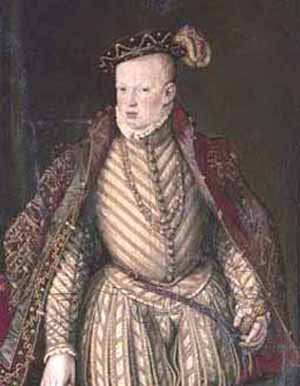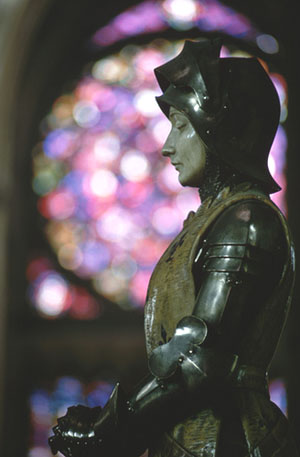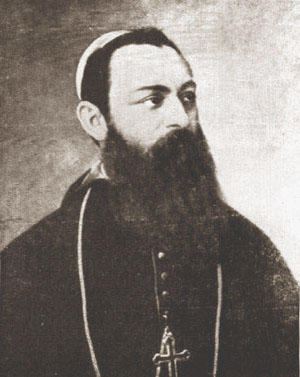 |
History: Personalities
Dom Sebastian & Other Interrupted Vocations
Plinio Corrêa de Oliveira
At times when we observe movements of soul, we note that something is missing. In the case of Dom Sebastian we see that this young King first raised hope in his people, then a sense of tragedy, followed by a nostalgia and longing for a lost grandeur. The cycle repeated with the expectation of his return and a miracle that would make it possible. Analyzing these cycles [see last article], it is clear that its culmination, the appearance of Our Lady of Fatima in Portugal, is incomparably sublime; notwithstanding, we would say that something is missing. Portugal still misses Dom Sebastian.

Dom Sebastian at age 15 |
Portugal needs a man with a Portuguese soul, who knows how to tell the world in the uniquely Portuguese style that Dom Sebastian has returned to earth. Not the physical Dom Sebastian, who existed in the 16th century, but the spirit of Dom Sebastian, his soul and his mission. I do not know how Portugal will beget this man. I do not know precisely how this star, this flower, will be. But I await his coming for Portugal.
Today Portugal lives in sadness caused by having its empire scattered, by being constantly scorned when compared with other European countries that entered the blind race for progress, and by bearing the succession of governments that are windscreens for the gradual communist takeover of the country. The Portuguese people are waiting for someone to come.
I believe that it is not an exaggeration to say that many Portuguese persons nurture this hope. Our Lady took Dom Sebastian from this life. She sees that many of her children in Portugal still weep for him, for the good he represented and for the great things he could not accomplish. Those people should be prepared because she will give much more than they expect. I also have this hope for Portugal.
I can see the effect this topic is causing in your spirit – you who are listening to these words. Such considerations make you feel as if you entered a higher sphere of dreams, as if you were living in a crystal world where the lights reflect in an extraordinary way, making a dance of marvelous colors. A world quite different from our prosaic and pragmatic world. You feel yourselves transported to a trans-sphere where your souls feel at home. This is the charm that comes as an effect when we address the hope of the return of Dom Sebastian.
Great vocations that are interrupted raise similar thoughts and feelings. Persons who were following the path of sanctity and whose lives tragically ended before the accomplishment of their vocations belong to this genre. For such persons, their lives in a certain way continue on earth even after they die, and often that post-life becomes greater than the actual life.
St. Joan of Arc’s mission continued after her death
Let us take the case of St. Joan of Arc, who lived before Dom Sebastian. She is a supreme example of a star and a flower of France. St. Joan of Arc also had an interrupted life. She expected to live longer than she did. It was for this reason that she threw herself from a tower trying to flee prison. But she did not manage to escape. Bishop Couchon’s intrigues favoring the English brought her to the fire, where she was tied to a post with dry wood beneath her feet and her tunic drenched with fuel. They set the wood afire and the flames quickly consumed her while she cried out: “Jesus, Mary!” the same names she had emblazoned on her standard. Her soul soared to Heaven.

Joan of Arc's vocation is still being fulfilled |
This life so brutally cut from existence had a post-life that in many ways was greater than her actual life. She became the symbol of France’s need to expel the English from its territory. In fact, the English did leave. One cannot imagine how harmful it would have been for France to come under Anglican influence, as it was under the Calvinist influence. The two Protestant influences could have completely destroyed what is still Catholic today in the French spirit. St. Joan of Arc prevented this from happening.
The example of St. Joan of Arc became a beacon that shone in all the resistances French Catholics made against Protestantism and against the atheistic and egalitarian French Revolution. I am sure that St. Jean of Arc shone in a special way on that day when, in 1909, St. Pius X beatified her in a pompous ceremony in St. Peter’s Basilica. He ordered his Encyclical Au milieu des sollicitudes, against the revolutionary French government, to be distributed among those countless French pilgrims who were present. A great attack against atheism and Freemasonry! Through the action of St. Pius X, the vocation of St. Joan of Arc continued. Once again she protected France against the enemies of the Catholic Faith.
She also gave birth to a spiritual family in France: those who admire her as a virgin-warrior, victorious in battle and a martyr in death, those who maintain a hope that beyond her death some marvelous thing for France still will come. Her history has many magnificent analogies with that of Dom Sebastian.
Another example, Bishop Dom Vital in Brazil
Another of these figures whose missions were interrupted is in Brazil: Dom Vital Maria Gonçalves de Oliveira, the extraordinary Capuchin Bishop of Olinda and Recife (1844-1878). He had a long black beard and thick eye-brows that ended in a thin long line, strong, serious eye-brows something like those of an Assyrian King. He had serene, clear and penetrating eyes, which were long and almond shaped. He used to say that he had never been in the presence of a person without discerning his deepest intentions.

Dom Vital, a lion against Freemasonry |
He was the perfect person to expose the Freemasons who had infiltrated into Catholic confraternities and associations and to excommunicate them. In truth he was a lion fighting against Freemasonry in the Brazilian Empire, which was trying to deny the rights of the Church and the Pope. He faced it with such energy that he raised what became known as the ‘Religious Question’ in Brazilian History.
He died poisoned by the Masons, who ordered a painter to mix poison in the paint of his prison cell. Since he was incarcerated for three years in that room, constantly breathing that air, the poison entered his system and he would die as a consequence of it at age 33.
He should have lived to perpetuate the virtue of intransigence, which was sadly lacking in so many Brazilian Catholics. He had the gift of awaking enthusiasm for this virtue. When he was a prisoner of the government on the Ilha das Cobras (Cobra Island) in Rio, people from throughout Brazil traveled there to meet him and congratulate him for his inflexible position against Freemasonry.
Like the life of the Lamb of God, who was crucified by his own people but who resurrected on the third day, those whose lives were cut short because of their love of God also have resurrections. Not physical resurrections, like that of Our Lord, but spiritual resurrections, the rising of the same spirit that animated their interrupted missions.
I believe that if we studied the lives of other peoples, we would find interrupted vocations of persons who lived in accordance with the Law of God and who left in their wake this kind of post-life. The liturgy says: Blessed are those who die in the Lord (Beati mortui qui in Domino moriuntur). We would paraphrase it in this way: Blessed are those whose lives were cut short, but whose noble vocations still endure.

Translated from the transcript of the tape
and summarized by A.S. Guimarães
Posted June 13, 2011

Related Topics of Interest
 Dom Sebastian’s Legacy Dom Sebastian’s Legacy
 Dom Sebastian, the Star of Portugal Dom Sebastian, the Star of Portugal
 Charles VII, King of France by Divine Delegation Charles VII, King of France by Divine Delegation
 Different Types of Nobility Different Types of Nobility
 The Death of St. Joan of Arc The Death of St. Joan of Arc
 The Timely Mission of St. Joan of Arc The Timely Mission of St. Joan of Arc
 Vocations of the European Peoples Vocations of the European Peoples

Related Works of Interest
  

|
History | Home | Books
| CDs | Search
| Contact Us | Donate

© 2002-
Tradition in Action, Inc. All Rights Reserved
|
 |
|